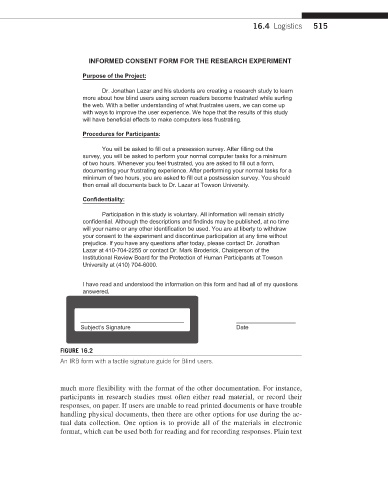Page 522 -
P. 522
16.4 Logistics 515
INFORMED CONSENT FORM FOR THE RESEARCH EXPERIMENT
Purpose of the Project:
Dr. Jonathan Lazar and his students are creating a research study to learn
more about how blind users using screen readers become frustrated while surfing
the web. With a better understanding of what frustrates users, we can come up
with ways to improve the user experience. We hope that the results of this study
will have beneficial effects to make computers less frustrating.
Procedures for Participants:
You will be asked to fill out a presession survey. After filling out the
survey, you will be asked to perform your normal computer tasks for a minimum
of two hours. Whenever you feel frustrated, you are asked to fill out a form,
documenting your frustrating experience. After performing your normal tasks for a
minimum of two hours, you are asked to fill out a postsession survey. You should
then email all documents back to Dr. Lazar at Towson University.
Confidentiality:
Participation in this study is voluntary. All information will remain strictly
confidential. Although the descriptions and findinds may be published, at no time
will your name or any other identification be used. You are at liberty to withdraw
your consent to the experiment and discontinue participation at any time without
prejudice. If you have any questions after today, please contact Dr. Jonathan
Lazar at 410-704-2255 or contact Dr. Mark Broderick, Chairperson of the
Institutional Review Board for the Protection of Human Participants at Towson
University at (410) 704-6000.
I have read and understood the information on this form and had all of my questions
answered.
Subject’s Signature Date
FIGURE 16.2
An IRB form with a tactile signature guide for Blind users.
much more flexibility with the format of the other documentation. For instance,
participants in research studies must often either read material, or record their
responses, on paper. If users are unable to read printed documents or have trouble
handling physical documents, then there are other options for use during the ac-
tual data collection. One option is to provide all of the materials in electronic
format, which can be used both for reading and for recording responses. Plain text

